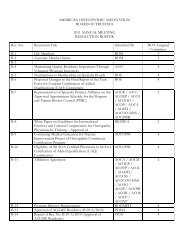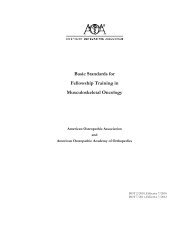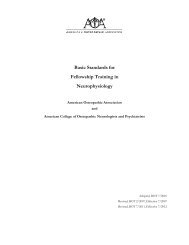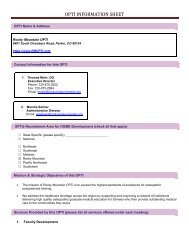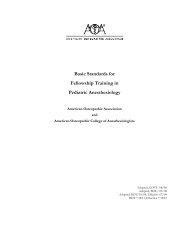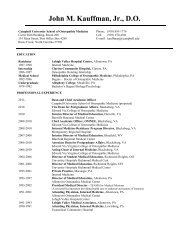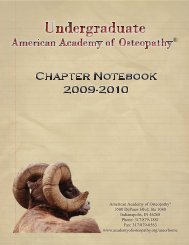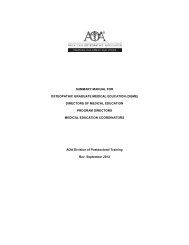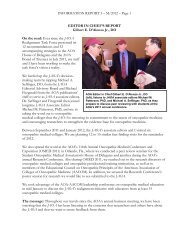Create successful ePaper yourself
Turn your PDF publications into a flip-book with our unique Google optimized e-Paper software.
Mood Disorders<br />
and OMM<br />
<strong>Teodor</strong> <strong>Huzij</strong> <strong>DO</strong> <strong>FACN</strong><br />
Medical Director, Trinity Institute<br />
1
Objectives<br />
1. Review literature for manual medicine<br />
and mood disorders<br />
2. Review Anatomy and Physiology related<br />
to current evidence for mood disorders<br />
3. Discuss proposed osteopathic<br />
manipulative medicine (OMM) interventions<br />
based on objectives 1 and 2.<br />
2
Outline<br />
Literature Review: Manual medicine & Mood<br />
Anatomy/Physiology Review: Mood related<br />
Proposed OMM for Mood Disorders<br />
3
Literature Review:<br />
Manual Medicine<br />
4
Overall<br />
Search terms included: “depression”, “major<br />
depressive disorder”, “dysthymic disorder”,<br />
“dysthymia”, “bipolar”, “manic depression”,<br />
“mood disorder”, “manual medicine”,<br />
“osteopathic”, “osteopathy”, “osteopathic<br />
manipulative treatment”, “osteopathic<br />
manipulative medicine”, “OMT”, “OMM”,<br />
“manual medicine”, “chiropractic”,<br />
“massage”, “manipulation” and “spinal<br />
manipulation”<br />
5
Citations Found<br />
Massage and Depression: 13<br />
OMT and Depression: 2<br />
Spinal manipulation and Depression: 1<br />
Massage and Bipolar: 1<br />
6
Massage - Depression<br />
4 studies: Patient’s with co-morbid condition<br />
(OA, CA, HIV, ESRD)- Decreased Depression<br />
2 studies: Pregnant women - Mixed results<br />
1992 Pilot Study: Inpt Psych C&A- Decreased<br />
Depression<br />
Choi 2006, Wilkinson 2007, Fulk 2004, McDougall 2005, Field 2004,<br />
Dimidjian 2009, Field 1992<br />
7
Massage - Depression<br />
Critical Reviews<br />
2002 - Immediate +, Long term No evidence<br />
2004 - Improvement = to psychotherapy<br />
2008 - RCTs did not support efficacy<br />
Manber 2002, Moyer 2004, Coelho 2008<br />
8
OMT - Depression<br />
Pilot Study: Adjunctive OMT with Paxil for<br />
Depressed Women<br />
20-50 y.o. Women, 8wks (weekly sessions)<br />
Control (9): Cognitive therapy,<br />
Neurolinguistic programming, Paxil, OSE<br />
Treatment (8): Same as control + OMT<br />
OMS administered, Physician supervised<br />
No specific OMT protocol (20 min limit)<br />
Plotkin. JAOA. Sep 2001<br />
OMT provided: low-impact tech-niques, such as soft tissue and facial release techniques<br />
performed on a find- and-fix basis.<br />
9
OMT - Depression<br />
Pilot Study: Adjunctive OMT with Paxil for<br />
Depressed Women<br />
Zung Depression Scale<br />
Both groups significantly better<br />
Control: 30% reached normal range<br />
OMT: 100% reached normal range<br />
Plotkin. JAOA. Sep 2001<br />
10
OMT - Depression<br />
Quality of life for OMT referrals<br />
SF-36 only admistered<br />
Lower quality of life vs controls<br />
Undetermined impact of OMT on QOL<br />
Licciardone. JAOA. Mar 2002<br />
11
Spinal Manipulation -<br />
Depression<br />
Systematic review of RCT for spinal<br />
manipulation and psychological outcomes<br />
Included osteopathic (2) and others<br />
Small significant benefit in first 5 mo<br />
Williams. Comp Therapies in Med. 2007<br />
12
Spinal Manipulation -<br />
Depression<br />
N.H. Willi<br />
Comparilon:<br />
0tJtc00wt·<br />
Uanlpulatkm wrwa talking ll'utment<br />
T.!klng .,utmfi SMO{lb •• • .)(I) 10.04. o.!51S1<br />
UK8EAM2004(GPr.are) :357 •• 24(10.127 O.1'H10.1i») (L)iJ 10.:H. 0.'5?]<br />
Cor,lbifl6ld (95% Ct) 6.)& .01 to"H. O.45}<br />
TMt lot heterogeneity. etta"" H)$. df =. 5 (P .,012), It ""29,1%<br />
-- •<br />
l- !U)3 (P..; 000001)<br />
,..<br />
., frrhmbslo2003 (a
yslotherapist. 4O<br />
One triaL from the USA for subacute low back<br />
n did not find a statistically Significant differ-<br />
Spinal Manipulation -<br />
Depression<br />
a cervicaL collar. 39 ALthough no baselin<br />
were reported and it was not possible to<br />
change scores, it was assumed that both g<br />
Cotnp,8rison:<br />
Ou\oom ..:<br />
Maniptllatioo V8r$U. phy...lttaatme:nt<br />
any plI'yt:hoIoglcal<br />
Spinal manipulation<br />
Physical erutmenl<br />
Ii Mo_.(SO) N "",_,,(SO)<br />
SMO{ftxed)<br />
95'4Cl<br />
SIAO!fi"""!<br />
95%CI<br />
Triano 1995 (sham) 4iJ 1.SOi7.00i<br />
., 2. 40{'l. (0)<br />
0,1.6 v.5?J<br />
1..5mmf1.<br />
Giebel 1997{oorviClicoHar) 4" 1.24!1tO.7S) SO 1.09(6.75; 11.2;: (-0.17, O.1!i;1j<br />
D....td1996(ac:t.Ip\inCture) ).,.5(1;,00) >.<br />
).6:2{6.001 -0.06 1-0.'59,. Q.4"<br />
)5 7.00na.(0) U a,{fO{U.OO) ..0,015 0.50J<br />
4' S.40{9'.601 1},0'1 [-o.n, 0.48)<br />
6) ).BP(lB.40J "6S l,S4{l8.40) I}.U 0.47)<br />
UK BEAM 2004 (m:ltfeiM) .lSi 4.H(lO.l{t\ 191 1.84(10.)0) 0,2) [0.05, 0.42]<br />
Oziedzic2005Cexerdse) 10' 0.ao(10.0()1 100 1.;;tO(lu.OO) 0,;;:1'<br />
(95.,. CI) , 5" 0,13 {O.U. 0 • .:.!'1<br />
Toatlot hoIerogeneitj: ""3,87. df. T (P -0.19). I' 21 0%<br />
Test for ovet':8!ll 6ffttet: Z. 2.15(P" 0,(3)<br />
8-121'l'1Ontha<br />
o.v1d 1_(acupuncwr.) :L Hi. OO}<br />
,.<br />
l.$::!t•.<br />
\t •. H {-0,2), 0.8\71)<br />
11 4.QI){1'.OOl ,. f;.OO(18.(J.O)<br />
-0,11 1-0.68, Q.4i$J<br />
Huriey2004(lfIwmrontkil) !SZ 4.'1"'(1,,40) 55 ,>.84 (.16,40) 0,21 1-0.17_ 0.591<br />
!JK8EAM2004 (.DtClH) 2!S'" 2,69(10,)0) ,.. L 37(10.).0) Q,n '''0.06, 0.121<br />
109 0.'101l0.0CJI 112 0,)0(10.001 0.04 1-0.22. O.${lj<br />
...<br />
CcmJ:Xned (95%. Cf) fE,<br />
Tettfothdtrogeneity. Ch* -1.12'. « .. 4 (p .. 0.19). P ",Q%.<br />
T..t r... o_,.1fec;I; l = 0.09)<br />
1.67 (P =<br />
-,<br />
11.11 0.25)<br />
Figure 3 Meta-analysis of trials of spinal manipulation compared with other physical treatments<br />
Williams. Comp Therapies in Med. 2007<br />
14
Massage - Bipolar<br />
Review of complimentary and alternative<br />
treatment for Bipolar<br />
Aromatherapy massage & Massage Therapy<br />
“almost entirely lacking” evidence<br />
Andreescu. Jrnl Aff Dis. 2008.<br />
15
Literature Summary<br />
Most Evidence: Massage Therapy for<br />
Depression but mixed<br />
OMT: Depression Pilot study is the best<br />
evidence<br />
16
Literature Review:<br />
Neuro - A&P<br />
17
MDD: Findings Vary<br />
Reduced Frontal Lobe<br />
volume<br />
Reduced Caudate<br />
Reduced Putamen<br />
Reduced CBF Anterior<br />
Cingulate Gyrus<br />
Increased CBF Medial<br />
Orbital Cortex<br />
Increased CBF Left<br />
Amygdala & Medial<br />
Thalamus<br />
Increased CBF<br />
Cerebellar Vermis<br />
Amygdala-Medial-<br />
Thalamus-Ventral-<br />
Prefrontal Cortex<br />
Limbic-Striatal-<br />
Pallidal-Thalamic<br />
Ebert 1996, Soares 1997, Drevets 1998, Daroff 2012<br />
18
MDD: Most Evidence<br />
Hypoperfusion Dorsolateral/Dorsomedial<br />
Prefrontal Cortex<br />
Increased CBF Medial Thalamus<br />
Hypoperfusion of Anterior Cingulate Gyrus<br />
Reduced Frontal Lobe volume<br />
Coffey 1993, Ito 1996, Ebert 1996, Soares 1997, Drevets 1998, Daroff 2012<br />
19
Bipolar: Findings Vary<br />
Bilateral anterior<br />
frontal<br />
Anterior cingulate<br />
gyrus<br />
Left superior<br />
temporal<br />
Bilateral anterior<br />
insular<br />
Cerebellar vermis<br />
Inferior prefrontal<br />
Amygdala<br />
Striatum<br />
Hippocampus<br />
Third ventricle<br />
Ito 1996, Soares 1997, Strakowski 2004, DelBello 2004, Lyoo 2006,<br />
William 2007, Ellison-Wright 2010<br />
21
Bipolar: Most Evidence<br />
Reduced Cerebellar Vermis Volume<br />
Right Anterior Cingulate Gyrus<br />
Left Superior Temporal Cortex<br />
Bilateral Insular Cortex<br />
Increased Striatum Volume<br />
Ito 1996, Soares 1997, Strakowski 2004, DelBello 2004, Lyoo 2006,<br />
William 2007, Ellison-Wright 2010<br />
Caudate and putamen make up the striatum and are a sub part of the basal ganglia<br />
22
Proposed OMM<br />
24
Not The Goal<br />
25
Osteopathic Philosophy<br />
1. Body is a Unit - Body, Mind, Spirit<br />
2. Structure and Function are Interrelated<br />
3. Self-healing Self-regulating Systems<br />
4. Rationale treatment includes prior 3<br />
Glossary of Osteopathic Terminology 2009, p33<br />
Interpersonal conflict is a manifestation of inflammation occurring between 2 structures<br />
(people) and their dyfunctional operation (conflict)<br />
26
Osteopathic Approach<br />
An osteopath reasons from his knowledge<br />
of anatomy - Still<br />
Principles of osteopathy follow the logic<br />
of an applied knowledge of anatomy-the<br />
science of structure, physiology-the<br />
science of function, and pathology-the<br />
science of disease - Webster<br />
Life is not a composite of the functions of<br />
the viscera - Korr<br />
Still-Research & Practice, Webster-Sage Sayings, Korr-Physiological basis<br />
27
General<br />
Biomechanical Goals<br />
Optimize Structure and Function<br />
Whole Body Assessment<br />
Sympathetic Nervous System<br />
Vascular System<br />
Lymphatic System<br />
Primary & Secondary Respiration<br />
Parasympathetic has no direct innervation of the brain.<br />
Cerebral arteries lose their peripheral nerve supply upon entry into the brain parenchyma.<br />
From then on they are under control of the “intrinsic innervation” as they receive neural input<br />
from neurons located within the brain itself.<br />
28
Common Treatments<br />
Sympathetic Nervous<br />
System<br />
T1-6<br />
Any modality<br />
29
Common Treatments<br />
Vascular<br />
Arterial<br />
Vertebrobasilar system, Post Comm<br />
Anterior Cerebral<br />
Middle Cerebral<br />
Venous<br />
Dural Sinuses and Jugular Vein<br />
Avoid treatment if a recent vascular event<br />
30
Vertebrobasilar system: C1-C2, OA, Suboccipital triangle, Foramen magnum<br />
31
Vertebrobasilar system: C1-C2, OA, Suboccipital triangle, Foramen magnum<br />
31
Vertebrobasilar system: C1-C2, OA, Suboccipital triangle, Foramen magnum<br />
31
Vertebrobasilar system: C1-C2, OA, Suboccipital triangle, Foramen magnum<br />
31
Vertebrobasilar system: C1-C2, OA, Suboccipital triangle, Foramen magnum<br />
31
Vertebrobasilar system: C1-C2, OA, Suboccipital triangle, Foramen magnum<br />
31
Vertebrobasilar system: C1-C2, OA, Suboccipital triangle, Foramen magnum<br />
31
Internal carotid to circle of willis: Temporal bone (cervical, petrous parts), Sphenoid<br />
(cavernous part), Circle of Willis (Located approximately at the juncture of lateral frontomaxillary<br />
and maxillo-zygomatic suture lines)<br />
32
Internal carotid to circle of willis: Temporal bone (cervical, petrous parts), Sphenoid<br />
(cavernous part), Circle of Willis (Located approximately at the juncture of lateral frontomaxillary<br />
and maxillo-zygomatic suture lines)<br />
32
Internal carotid to circle of willis: Temporal bone (cervical, petrous parts), Sphenoid<br />
(cavernous part), Circle of Willis (Located approximately at the juncture of lateral frontomaxillary<br />
and maxillo-zygomatic suture lines)<br />
32
Internal carotid to circle of willis: Temporal bone (cervical, petrous parts), Sphenoid<br />
(cavernous part), Circle of Willis (Located approximately at the juncture of lateral frontomaxillary<br />
and maxillo-zygomatic suture lines)<br />
32
Anterior cerebral artery: Metopic suture to coronal suture<br />
33
Anterior cerebral artery: Metopic suture to coronal suture<br />
33
Anterior cerebral artery: Metopic suture to coronal suture<br />
33
Anterior cerebral artery: Metopic suture to coronal suture<br />
33
Middle cerebral artery: From Circle of Willis along superior temporal lobe<br />
34
Middle cerebral artery: From Circle of Willis along superior temporal lobe<br />
34
Middle cerebral artery: From Circle of Willis along superior temporal lobe<br />
34
Middle cerebral artery: From Circle of Willis along superior temporal lobe<br />
34
Middle cerebral artery: From Circle of Willis along superior temporal lobe<br />
34
Internal carotid to circle of willis: Temporal bone (cervical, petrous parts), Sphenoid<br />
(cavernous part), Circle of Willis (Located approximately at the juncture of lateral frontomaxillary<br />
and maxillo-zygomatic suture lines)<br />
35
Internal carotid to circle of willis: Temporal bone (cervical, petrous parts), Sphenoid<br />
(cavernous part), Circle of Willis (Located approximately at the juncture of lateral frontomaxillary<br />
and maxillo-zygomatic suture lines)<br />
35
Internal carotid to circle of willis: Temporal bone (cervical, petrous parts), Sphenoid<br />
(cavernous part), Circle of Willis (Located approximately at the juncture of lateral frontomaxillary<br />
and maxillo-zygomatic suture lines)<br />
35
Internal carotid to circle of willis: Temporal bone (cervical, petrous parts), Sphenoid<br />
(cavernous part), Circle of Willis (Located approximately at the juncture of lateral frontomaxillary<br />
and maxillo-zygomatic suture lines)<br />
35
Internal carotid to circle of willis: Temporal bone (cervical, petrous parts), Sphenoid<br />
(cavernous part), Circle of Willis (Located approximately at the juncture of lateral frontomaxillary<br />
and maxillo-zygomatic suture lines)<br />
35
Internal carotid to circle of willis: Temporal bone (cervical, petrous parts), Sphenoid<br />
(cavernous part), Circle of Willis (Located approximately at the juncture of lateral frontomaxillary<br />
and maxillo-zygomatic suture lines)<br />
35
Internal carotid to circle of willis: Temporal bone (cervical, petrous parts), Sphenoid<br />
(cavernous part), Circle of Willis (Located approximately at the juncture of lateral frontomaxillary<br />
and maxillo-zygomatic suture lines)<br />
35
Internal carotid to circle of willis: Temporal bone (cervical, petrous parts), Sphenoid<br />
(cavernous part), Circle of Willis (Located approximately at the juncture of lateral frontomaxillary<br />
and maxillo-zygomatic suture lines)<br />
35
Internal carotid to circle of willis: Temporal bone (cervical, petrous parts), Sphenoid<br />
(cavernous part), Circle of Willis (Located approximately at the juncture of lateral frontomaxillary<br />
and maxillo-zygomatic suture lines)<br />
35
Common Treatments<br />
Lymphatic System<br />
Open Thoracic Inlet<br />
36
Common Treatments<br />
Secondary Respiration<br />
Re-dome Abdominal Diaphragm<br />
38
Treating Cortical<br />
Tissue<br />
Avoid if recent vascular event<br />
Balanced Membranous Tension<br />
Assess<br />
Tension, Restriction<br />
Laxity, void<br />
Seek balance<br />
39<br />
Biomechanical anatomic connections: Scalp, cranial bones, dura, arachnoid, pia, extracellular<br />
matrix, neuronal cell wall, intracellular contents
Major Depressive D/O<br />
Hypoperfusion Dorsolateral/Dorsomedial<br />
Prefrontal Cortex<br />
Vascular: Anterior & Middle Cerebral<br />
Arteries<br />
1° Respiration:<br />
40
Hold: DMPFC- Fingers along metopic suture from nasion to coronal suture (bregma). DLPFC-<br />
Structures: DMPFC-Anterior falx cerebri (crista gali, metopic suture to coronal suture:<br />
ethmoid, frontals, anterior dural girdle). DLPFC- Ipsilateral frontal bone.<br />
41
Hold: DMPFC- Fingers along metopic suture from nasion to coronal suture (bregma). DLPFC-<br />
Structures: DMPFC-Anterior falx cerebri (crista gali, metopic suture to coronal suture:<br />
ethmoid, frontals, anterior dural girdle). DLPFC- Ipsilateral frontal bone.<br />
41
Hold: DMPFC- Fingers along metopic suture from nasion to coronal suture (bregma). DLPFC-<br />
Structures: DMPFC-Anterior falx cerebri (crista gali, metopic suture to coronal suture:<br />
ethmoid, frontals, anterior dural girdle). DLPFC- Ipsilateral frontal bone.<br />
41
Hold: DMPFC- Fingers along metopic suture from nasion to coronal suture (bregma). DLPFC-<br />
Structures: DMPFC-Anterior falx cerebri (crista gali, metopic suture to coronal suture:<br />
ethmoid, frontals, anterior dural girdle). DLPFC- Ipsilateral frontal bone.<br />
41
Hold: DMPFC- Fingers along metopic suture from nasion to coronal suture (bregma). DLPFC-<br />
Structures: DMPFC-Anterior falx cerebri (crista gali, metopic suture to coronal suture:<br />
ethmoid, frontals, anterior dural girdle). DLPFC- Ipsilateral frontal bone.<br />
41
Hold: DMPFC- Fingers along metopic suture from nasion to coronal suture (bregma). DLPFC-<br />
Structures: DMPFC-Anterior falx cerebri (crista gali, metopic suture to coronal suture:<br />
ethmoid, frontals, anterior dural girdle). DLPFC- Ipsilateral frontal bone.<br />
41
Major Depressive D/O<br />
Increased CBF Medial Thalamus<br />
Vascular: Vertebrobasilar, Post Comm Art<br />
1° Respiration:<br />
42
Hold: Glabella to Lambda make ring with finger contacts and hand (modified fronto-occipital<br />
Structures: Tour of the minnow- 3rd ventricle lateral walls made up by the thalamus.<br />
Attending to fluid dynamics can be the most approximate handle on the thalamus.<br />
43
Hold: Glabella to Lambda make ring with finger contacts and hand (modified fronto-occipital<br />
Structures: Tour of the minnow- 3rd ventricle lateral walls made up by the thalamus.<br />
Attending to fluid dynamics can be the most approximate handle on the thalamus.<br />
43
Hold: Glabella to Lambda make ring with finger contacts and hand (modified fronto-occipital<br />
Structures: Tour of the minnow- 3rd ventricle lateral walls made up by the thalamus.<br />
Attending to fluid dynamics can be the most approximate handle on the thalamus.<br />
43
Hold: Glabella to Lambda make ring with finger contacts and hand (modified fronto-occipital<br />
Structures: Tour of the minnow- 3rd ventricle lateral walls made up by the thalamus.<br />
Attending to fluid dynamics can be the most approximate handle on the thalamus.<br />
43
Major Depressive D/O<br />
Hypoperfusion of Anterior Cingulate Gyrus<br />
Vascular: Anterior Cerebral Artery<br />
1° Respiration:<br />
44
Hold: Bilateral: fingers of both hands on both sides of metopic suture to coronal suture with<br />
Structures: Anterior falx cerebri (crista gali, metopic suture to coronal suture: ethmoid,<br />
frontals, anterior dural girdle).<br />
45
Hold: Bilateral: fingers of both hands on both sides of metopic suture to coronal suture with<br />
Structures: Anterior falx cerebri (crista gali, metopic suture to coronal suture: ethmoid,<br />
frontals, anterior dural girdle).<br />
45
Hold: Bilateral: fingers of both hands on both sides of metopic suture to coronal suture with<br />
Structures: Anterior falx cerebri (crista gali, metopic suture to coronal suture: ethmoid,<br />
frontals, anterior dural girdle).<br />
45
Hold: Bilateral: fingers of both hands on both sides of metopic suture to coronal suture with<br />
Structures: Anterior falx cerebri (crista gali, metopic suture to coronal suture: ethmoid,<br />
frontals, anterior dural girdle).<br />
45
Hold: Bilateral: fingers of both hands on both sides of metopic suture to coronal suture with<br />
Structures: Anterior falx cerebri (crista gali, metopic suture to coronal suture: ethmoid,<br />
frontals, anterior dural girdle).<br />
45
Major Depressive D/O<br />
Reduced Frontal Lobe volume<br />
Vascular: Anterior Cerebral Artery<br />
1° Respiration:<br />
46
Structures: Sphenoid. Frontal bones.<br />
47<br />
Hold: Fingers lay on full frontal bone area bilaterally.
Structures: Sphenoid. Frontal bones.<br />
47<br />
Hold: Fingers lay on full frontal bone area bilaterally.
Structures: Sphenoid. Frontal bones.<br />
47<br />
Hold: Fingers lay on full frontal bone area bilaterally.
Bipolar D/O<br />
Reduced Cerebellar Vermis Volume<br />
Vascular: Vertebral and Basilar arteries<br />
1° Respiration:<br />
48
Hold: Bilateral fingertips at inferior nuchal line toward the foramen magnum with PIP/MCP<br />
joints at the superior nuchal line/inion<br />
Structures: Tentorium cerebelli, occiput.<br />
49
Hold: Bilateral fingertips at inferior nuchal line toward the foramen magnum with PIP/MCP<br />
joints at the superior nuchal line/inion<br />
Structures: Tentorium cerebelli, occiput.<br />
49
Hold: Bilateral fingertips at inferior nuchal line toward the foramen magnum with PIP/MCP<br />
joints at the superior nuchal line/inion<br />
Structures: Tentorium cerebelli, occiput.<br />
49
Hold: Bilateral fingertips at inferior nuchal line toward the foramen magnum with PIP/MCP<br />
joints at the superior nuchal line/inion<br />
Structures: Tentorium cerebelli, occiput.<br />
49
Bipolar D/O<br />
Right Anterior Cingulate Gyrus<br />
Vascular: Anterior Cerebral Artery<br />
1° Respiration:<br />
50
Hold: Unilateral: Right hand fingers along metopic suture and thumb at mid lateral edge of<br />
Structures: Anterior falx cerebri (crista gali, metopic suture to coronal suture: ethmoid,<br />
frontals, anterior dural girdle).<br />
51
Hold: Unilateral: Right hand fingers along metopic suture and thumb at mid lateral edge of<br />
Structures: Anterior falx cerebri (crista gali, metopic suture to coronal suture: ethmoid,<br />
frontals, anterior dural girdle).<br />
51
Hold: Unilateral: Right hand fingers along metopic suture and thumb at mid lateral edge of<br />
Structures: Anterior falx cerebri (crista gali, metopic suture to coronal suture: ethmoid,<br />
frontals, anterior dural girdle).<br />
51
Hold: Unilateral: Right hand fingers along metopic suture and thumb at mid lateral edge of<br />
Structures: Anterior falx cerebri (crista gali, metopic suture to coronal suture: ethmoid,<br />
frontals, anterior dural girdle).<br />
51
Bipolar D/O<br />
Left Superior Temporal Cortex<br />
Vascular: Middle Cerebral Artery<br />
1° Respiration:<br />
52
Hold: Medial hand- Fingers along line from greater wing of sphenoid to above the mastoid<br />
process on the parietal. Lateral hand ipsilateral temporal hold<br />
Structures: sphenoid, temporal and parietal<br />
53
Hold: Medial hand- Fingers along line from greater wing of sphenoid to above the mastoid<br />
process on the parietal. Lateral hand ipsilateral temporal hold<br />
Structures: sphenoid, temporal and parietal<br />
53
Hold: Medial hand- Fingers along line from greater wing of sphenoid to above the mastoid<br />
process on the parietal. Lateral hand ipsilateral temporal hold<br />
Structures: sphenoid, temporal and parietal<br />
53
Hold: Medial hand- Fingers along line from greater wing of sphenoid to above the mastoid<br />
process on the parietal. Lateral hand ipsilateral temporal hold<br />
Structures: sphenoid, temporal and parietal<br />
53
Hold: Medial hand- Fingers along line from greater wing of sphenoid to above the mastoid<br />
process on the parietal. Lateral hand ipsilateral temporal hold<br />
Structures: sphenoid, temporal and parietal<br />
53
Hold: Medial hand- Fingers along line from greater wing of sphenoid to above the mastoid<br />
process on the parietal. Lateral hand ipsilateral temporal hold<br />
Structures: sphenoid, temporal and parietal<br />
53
Hold: Medial hand- Fingers along line from greater wing of sphenoid to above the mastoid<br />
process on the parietal. Lateral hand ipsilateral temporal hold<br />
Structures: sphenoid, temporal and parietal<br />
53
Bipolar D/O<br />
Bilateral Insular Cortex<br />
Vascular: Middle Cerebral Artery<br />
1° Respiration:<br />
54
Hold: Bilateral fingers along straight line from zygomatic process of frontal to apex of<br />
squamous temporal juncture with parietal. Unilateral- medial hand along line from zygomatic<br />
Structures: Frontal, sphenoid, parietal, temporal bones.<br />
55
Hold: Bilateral fingers along straight line from zygomatic process of frontal to apex of<br />
squamous temporal juncture with parietal. Unilateral- medial hand along line from zygomatic<br />
Structures: Frontal, sphenoid, parietal, temporal bones.<br />
55
Hold: Bilateral fingers along straight line from zygomatic process of frontal to apex of<br />
squamous temporal juncture with parietal. Unilateral- medial hand along line from zygomatic<br />
Structures: Frontal, sphenoid, parietal, temporal bones.<br />
55
Hold: Bilateral fingers along straight line from zygomatic process of frontal to apex of<br />
squamous temporal juncture with parietal. Unilateral- medial hand along line from zygomatic<br />
Structures: Frontal, sphenoid, parietal, temporal bones.<br />
55
Hold: Bilateral fingers along straight line from zygomatic process of frontal to apex of<br />
squamous temporal juncture with parietal. Unilateral- medial hand along line from zygomatic<br />
Structures: Frontal, sphenoid, parietal, temporal bones.<br />
55
Hold: Bilateral fingers along straight line from zygomatic process of frontal to apex of<br />
squamous temporal juncture with parietal. Unilateral- medial hand along line from zygomatic<br />
Structures: Frontal, sphenoid, parietal, temporal bones.<br />
55
Hold: Bilateral fingers along straight line from zygomatic process of frontal to apex of<br />
squamous temporal juncture with parietal. Unilateral- medial hand along line from zygomatic<br />
Structures: Frontal, sphenoid, parietal, temporal bones.<br />
55
Hold: Bilateral fingers along straight line from zygomatic process of frontal to apex of<br />
squamous temporal juncture with parietal. Unilateral- medial hand along line from zygomatic<br />
Structures: Frontal, sphenoid, parietal, temporal bones.<br />
55
Hold: Bilateral fingers along straight line from zygomatic process of frontal to apex of<br />
squamous temporal juncture with parietal. Unilateral- medial hand along line from zygomatic<br />
Structures: Frontal, sphenoid, parietal, temporal bones.<br />
55
Bipolar D/O<br />
Increased Striatum Volume<br />
Vascular: Vertebral and Basilar<br />
1° Respiration:<br />
56
Hold: Bilateral fingers along straight line from zygomatic process of frontal to apex of<br />
squamous temporal juncture with parietal. Unilateral: Lateral hand along straight line from<br />
Structures: Frontal, sphenoid, parietal, temporal bones.<br />
57
Hold: Bilateral fingers along straight line from zygomatic process of frontal to apex of<br />
squamous temporal juncture with parietal. Unilateral: Lateral hand along straight line from<br />
Structures: Frontal, sphenoid, parietal, temporal bones.<br />
57
Hold: Bilateral fingers along straight line from zygomatic process of frontal to apex of<br />
squamous temporal juncture with parietal. Unilateral: Lateral hand along straight line from<br />
Structures: Frontal, sphenoid, parietal, temporal bones.<br />
57
Hold: Bilateral fingers along straight line from zygomatic process of frontal to apex of<br />
squamous temporal juncture with parietal. Unilateral: Lateral hand along straight line from<br />
Structures: Frontal, sphenoid, parietal, temporal bones.<br />
57
Hold: Bilateral fingers along straight line from zygomatic process of frontal to apex of<br />
squamous temporal juncture with parietal. Unilateral: Lateral hand along straight line from<br />
Structures: Frontal, sphenoid, parietal, temporal bones.<br />
57
Hold: Bilateral fingers along straight line from zygomatic process of frontal to apex of<br />
squamous temporal juncture with parietal. Unilateral: Lateral hand along straight line from<br />
Structures: Frontal, sphenoid, parietal, temporal bones.<br />
57
Hold: Bilateral fingers along straight line from zygomatic process of frontal to apex of<br />
squamous temporal juncture with parietal. Unilateral: Lateral hand along straight line from<br />
Structures: Frontal, sphenoid, parietal, temporal bones.<br />
57
Hold: Bilateral fingers along straight line from zygomatic process of frontal to apex of<br />
squamous temporal juncture with parietal. Unilateral: Lateral hand along straight line from<br />
Structures: Frontal, sphenoid, parietal, temporal bones.<br />
57
Other Options?<br />
Cranial Vertebrae<br />
Charlotte Weaver <strong>DO</strong><br />
Biodynamics<br />
James Jealous <strong>DO</strong><br />
Brain Curriculum<br />
Bruno Chikly MD <strong>DO</strong><br />
58
SUMMARY<br />
Limited Evidence for OMM in Mood d/o<br />
Limited Evidence of anatomical/<br />
physiological correlates in Mood d/o<br />
Rationale Approach utilizing OMM in Mood<br />
d/o<br />
59
QUESTIONS?<br />
60



